Updated 7 Apr 2009
|
Felling a large dead oak
|
|
R1112
Red oak,
Quercus rubra, planted 1850.
"...easy to recognize by its bark, which features ridges
that appear to have shiny stripes down the center,
all the way down the trunk"
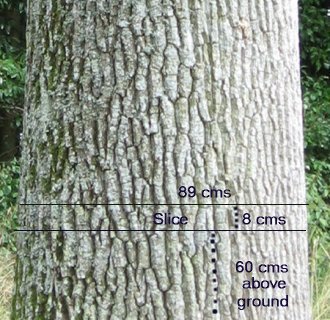
Height 31 m, Girth 2.87 m, felled 23 Aug 2008.
This slice will be used to count rings, dry, varnish and display
at the
Oak Fair at Stock Gaylard, Dorset on 29 August 2009
together with many wooden objects made from the same tree
by 25 other exhibitors.
|
Felling a large dead oak
|
A celebration of the life and death of an oak tree in England.
|
PRESS RELEASE
"A dead oak tree will be felled by
Adam's Axemen on
the edge of the Church Park and then all parts of the tree will be
distributed around the show site to a number of the exhibitors who
have asked to be involved (some 25). They will then use the timber
in their own way for furniture crafts etc. These exhibitors will
then bring back the products they have made from this oak to create
a unique exhibition at the 2009 Oak Fair."
Stock Gaylard Oak Fair
July 2008
See also Emails about this tree.
If you are involved, please email 
|
|
The author managed to persuade the organisers to cut and supply him
a "Salami-slice" from the bottom of the trunk.
The idea is to photo and analyse the annual growth rings,
to derive the age and rate of growth of the tree.
The slice will be dried, sanded and varnished for exhibition.
The results will be displayed at the fair in August 2009 under
the ITF (
International Tree Foundation) banner. This webpage celebrates
the life and death of a Red Oak "Quercus Rubra".
See the extreme weather suffered by the tree.
 . .
|
|
R1114 The dead oak after cutting with
"Aussie speed axes". Axe work clears the loose bark to
prepare for saw work. The notches help steer the fall of the tree.
Before felling, a roped climber cut off the largest lower branches
with a chainsaw
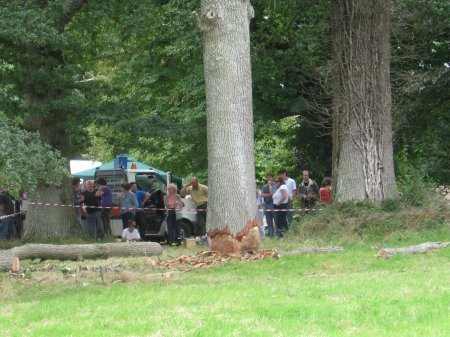 |
R1115 The dead oak falling. Final work
was done with 2-man crosscut saw and wedges. Saw work produces a smooth surface.
The upper third of the oak was smashed by the fall. The audience was
moved out of range before felling (health and safety).
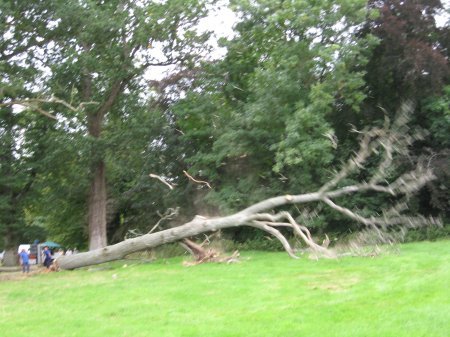 |
Five inch magnesium felling wedge.
Helps open the cut, steer the tree,
prevents the tree falling backwards.
Should be kept sharp.
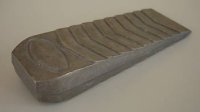
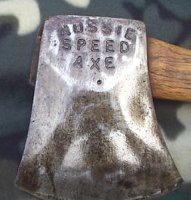
|
"Aussie Speed Axe"
The type used by Adam's Axemen to fell the oak. It is an Australian
wood choppers axe used in competition. On one side of the head is a
kangaroo centred in the map of Australia, with the numerals "89" in
one corner of the axe head and the letter "K" in the other corner.
On the reverse side are the word "Aussie Speed Axe". The handle made
of hickory, has various marks used by the axeman to steady his grip.
Total length with handle = 75cm
head width = 15cm,
head length = 18cm,
weight approx 1 kg
|
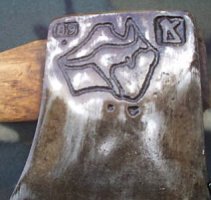
|
|
R1116 The cut stump. Saw work gives very
smooth surface, axe work none. Chain-saw surface
would be poor. Blue marks of wedge to open saw cut, cup of tea essential.
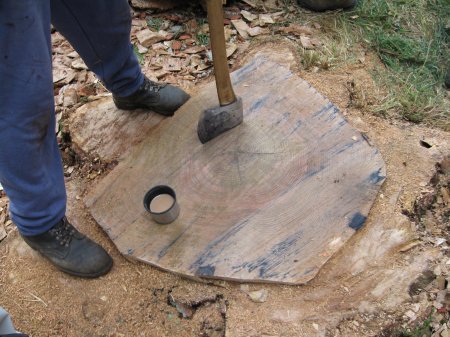
The outer half of the cross-section was cut by by axe,
the smooth central area by two-man crosscut saw.
Wedges were placed to steer the falling tree.
The long straight edge by the axeman's left foot shows the hinge
when the oak finally fell, steered exactly.
|
R1117 Cutting a 12 foot length with a
two-man saw. The cut is kept open with a hammered wedge. Saw teeth
need to be sharp, work gets harder nearer the ground.
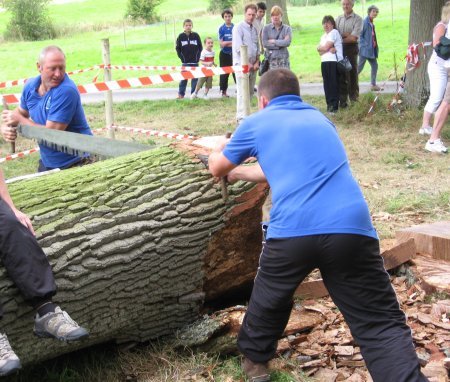 |
How the big saw works
Teeth on the 2-man crosscut saw.
cutters gullet raker gullet cutters
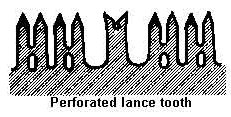 |
"...As described, saws will have cutters, rakers, and gullets. As the saw is
pulled toward the operator, the cutters along the saw's surface scores
the wood to the left and right of the width of the blade, cutting a
channel downward into the wood. In many saws there are four cutters, one
which cuts left, another which cuts right, then another pair of left and
right cutters.
After the cutters there is generally a raker followed by a gullet. A raker
is what does the actual removal of the wood that is being cut. The raker
follows the cutters, scraping the bottom of the kerf being cut. As the
raker scrapes the bottom of the channel being cut, the wood is peeled back
and stored in the gullet which follows the raker.
As the saw is drawn out of the log, the accumulated wood being stored in
the gullets in the saw are allowed to fall out onto the ground. A way to
determine whether a saw is working well is to examine the noodle shaped
wood that gets scraped out of the log being cut. Fairly long strings of
wood coming out of the log being cut indicates that the side cutters are
doing their job and that the raker is slicing out the wood cleanly."
(Wikipedia)
|
R1156 Victorian 2-man saw, 1 metre between handles.......
 |
R1157 .....with plain saw teeth, 9 teeth in 13 cms.
 |
R1120 Cutting a Salami-slice for the author.
The art is keeping the two cuts 8 cms apart, parallel, and open with
a wedge. The saw must cut right across the trunk.
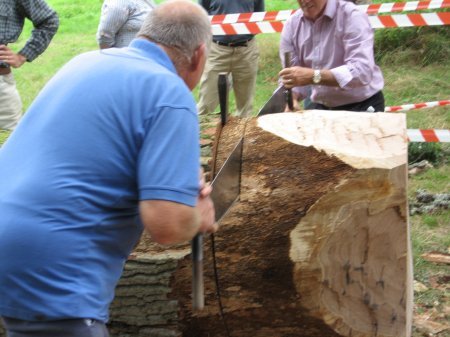 |
R1121 The salami-slice ready for
close-up photography of the rings. The saw cut
is very smooth. A band of marked-up graph paper is pinned to a radius for
reference.
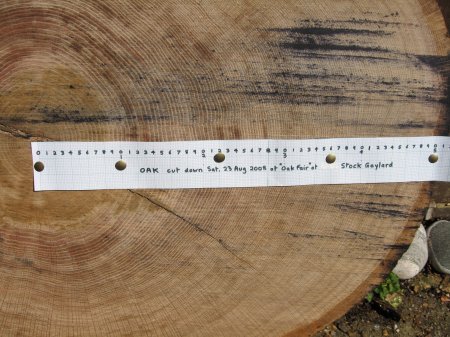 |
GIRTH
cms cms
Year Radius ΔGirth/yr Age
1850 0.0 0
1860 3.6 2.26 10
1870 8.2 2.89 20
1880 13.7 3.45 30
1890 18.6 3.08 40
1900 22.8 2.64 50
1910 26.3 2.20 60
1920 29.2 1.82 70
1930 31.9 1.70 80
1940 34.3 1.51 90
1950 36.8 1.57 100
1960 38.7 1.19 110
1970 41.0 1.44 120
1980 43.2 1.38 130
1990 45.6 1.51 140
2000 47.9 1.44 150
2008 50.1 1.73 158
|
Average increase of oak GIRTH per year (cms)
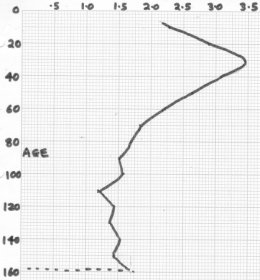
|
DIMENSIONS
3,168 cm Height of tree
287 cm Circumference of slice
8.0 cm Thickness of slice (average)
6,555 cm2 Area of slice (approx)
52,438 cm3 Volume of slice (approx)
|
NOTES
- Earlywood grows quickly in spring and summer and
is light coloured and less dense.
- Latewood grows slowly in Autumn and winter and
is dark coloured and more dense.
- RED DOTS mark the change from
earlywood to latewood, easier to identify.
- BLUE GRAPH paper has small squares 2mm on
a side.
- 158 rings identified, covering a radius of
51 cms, a girth of 287 cms on felling.
- The tree was felled when dead in August 2008, pointing to a
planting date of 1850.
- Maximum rate of Girth increase 3.45 cms/year at age 30 years.
- Rate of Girth increase reduced to 1.5 cms/year at age 150 years.
- In the tree's lifetime, world population grew from
1.262 Billion to 6.684 Billion.
|
|
DRYING
Wood dried in author's garage under a sunny window.
Density range quoted for this type of wood 0.59-0.93.
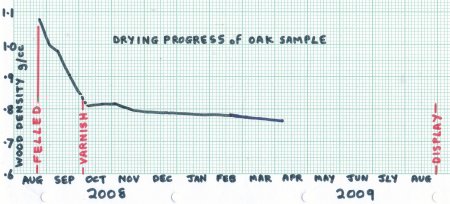
|
DRYING PROGRESS
Days Date Weight Density Loss
2 25 Aug 08 56.5 kg 1.077 g/cc 0%
10 02 Sep 52.5 1.001 7
18 10 Sep 51.5 0.982 9
29 21 Sep 47.5 0.906 16
39 01 Oct 44.5 0.849 21
02-05 Oct Sample trimmed, sanded and varnished.
45 07 Oct 42.5 0.810 25
59 21 Oct 43.0 0.820 24
71 02 Nov 43.0 0.820 24
88 19 Nov 41.75 0.796 26
180 19 Feb 09 41.25 0.786 27
227 07 Apr 40.0 0.763 29
29 Aug 09 Display oak section at Oak Fair.
|
VARNISHING
- Varnished at density = 0.850g/cc to stop drying and cracking.
- Wood projecting above each face removed by sawing and sanding.
- Dark areas caused by saw and wedge removed by sanding.
- Tree data written along edge of bare wood with blue ballpoint pen.
- Three coats of varnish applied to each face.
-
Ronseal clear satin quick drying interior varnish applied which
"brings out the inherent beauty of wood, enhancing the natural
wood grain with a non-yellowing, crystal clear satin finish".
|
|
Display for Oak Fair 2009
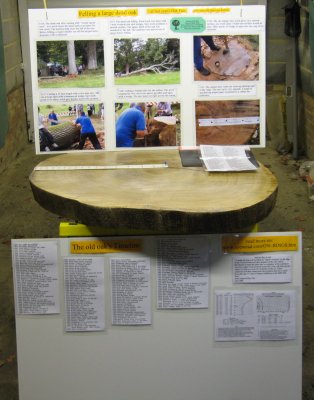
|
DISPLAY for Hire
'crystallized time'
|
A display of the oak slice and its rings
has been prepared for the next Oak Fair in 2009.
The varnished slice rests on two saw horses which can stand
on grass or hard flooring. Two men are required to move
the 43 kg slice safely. Mounted laminated
photos and text contain most that is on this
webpage. A radius tape allows dating each ring
and a handbook gives a complete Timeline.
The slice is very pleasant to the touch, and the
clear rings are a delight to see.
The complete display can be brought
by car and is available free for environmental
meetings.
Dimensions of the assembled display are:
1.5 m high x 1.0 m wide x 1.0 m deep.
Contact the author on

|
The Northern RED OAK or Champion Oak
Quercus rubra (syn. Quercus borealis), is an oak in the red oak group (Quercus section Lobatae). It is a native of North America, in the northeastern United States and southeast Canada. It grows from the north end of the Great Lakes, east to Nova Scotia, south as far as Georgia and states with good soil that is slightly acidic. Often simply called "Red Oak", northern red oak is formally so named to distinguish it from southern red oak (Q. falcata), also known as the Spanish oak.
Description
In forests, the northern red oak grows straight and tall, to 35 m (115 ft), exceptionally to 43 m (140 ft) tall, with a trunk of up to 1 m (3 ft) diameter; open-grown trees do not get so tall, but can develop a stouter trunk, up to 2 m (6 ft) in diameter. It has stout branches growing at right angles to the stem, forming a narrow round-topped head. It grows rapidly and is tolerant of many soils and varied situations, although it prefers the glacial drift and well-drained borders of streams.
Detail of mature bark
A 10-year-old tree will be about 5 m (15 ft) tall.
Northern red oak is easy to recognize by its bark, which features bark ridges that appear to have shiny stripes down the center. A few other oaks have bark with this kind of appearance in the upper tree, but the northern red oak is the only tree with the striping all the way down the trunk.
Bark: Dark reddish gray brown, with broad, thin, rounded ridges, scaly. On young trees and large stems, smooth and light gray. Rich in tannic acid. Branchlets slender, at first bright green, shining, then dark red, finally dark brown. Bark is brownish gray, becoming dark brown on old trees.
Wood: Pale reddish brown herpes, sapwood darker, heavy, hard, strong, coarse-grained. Checks in drying, but when carefully treated could be successfully used for furniture. Also used in construction and for interior finish of houses. Sp. gr., 0.6621; weight of cu. ft., 41.25 lbs.
Winter buds: Dark chestnut brown, ovate, acute, one-fourth of an inch long.
Leaves: Alternate, seven to nine-lobed, oblong-ovate to oblong, five to ten inches long, four to six inches broad; seven to eleven lobes tapering gradually from broad bases, acute, and usually repandly dentate and terminating with long bristle-pointed teeth; the second pair of lobes from apex are largest; midrib and primary veins conspicuous. Lobes are less deeply cut than most other oaks of the red oak group (except for black oak which can be similar). Leaves emerge from the bud convolute, pink, covered with soft silky down above, coated with thick white tomentum below. When full grown are dark green and smooth, sometimes shining above, yellow green, smooth or hairy on the axils of the veins below. In autumn they turn a rich red, sometimes brown. Often the petiole and midvein are a rich red color in midsummer and early autumn, though this is not true of all red oaks. Petioles are stout, one to two inches long, often red; stipules caducous.
Flowers: May, when leaves are half grown. Staminate aments four to five inches long, hairy. Calyx four to five-lobed, greenish; stamens four to five; filaments slender; anthers yellow. Pistillate flowers borne on short peduncles; involucral scales broadly ovate, dark reddish-brown; stigmas elongated, bright green.
Acorns: Ripen in the spring of the second year, about 18 months after pollination; solitary or in pairs, sessile or stalked; nut oblong-ovoid with broad flat base, full, with acute apex, one half to one and one-fourth of an inch long, first green, maturing nut-brown; cup, saucer-shaped and shallow, 2cm (0.8 in) wide, usually covering only the base, sometimes one-fourth of the nut, thick, shallow, reddish brown, somewhat downy within, covered with thin imbricated reddish brown scales. Kernel white and very bitter. Despite this bitterness, they are eaten by deer, squirrels and birds.
In forests, the northern red oak grows straight and tall, to 35 m (115 ft), exceptionally to 43 m (141 ft) tall, with a trunk of up to 1 m diameter; open-grown trees do not get so tall, but can develop a stouter trunk, up to 2 m (6.6 ft) in diameter. Has stout branches growing at right angles to the stem, forming a narrow round-topped head. It grows rapidly and is tolerant of many soils and varied situations although prefers the glacial drift and well-drained borders of streams.
Uses
The northern red oak is one of the most important oaks for timber production in North America. The wood is of high value. Other related oaks are also cut and marketed as Red Oak, although their wood is not always of as high a quality. These include black oak, scarlet oak, pin oak, shumard oak, southern red oak and other species in the red oak group. The northern red oak is widely planted and naturalized also in Central Europe.
Red oak wood grain is so open that smoke can be blown through it from end-grain to end-grain on a flatsawn board.
(Wikipedia)
|
EXCEPTIONAL WEATHER suffered by this tree 1850-1895
1. 8th WETTEST in the EWP series.
1851/52 & 1852/53: (Winter/Springs)
1. The winter of 1851/52 in Scotland saw some HEAVY SNOWFALL. The first major
event affected the north of Scotland on the 13th with considerable disruption
to mail services. The railway to Aberdeen from the south was kept open only
with difficulty. It was reported that deaths occurred, due to often BLIZZARD
conditions. The storms did not continue beyond the end of January.
2. The winter of 1852/53 in Scotland also was SEVERE, particularly in February.
Low TEMPERATURES and HEAVY SNOWFALL. This time, severe conditions of cold and
snow lasted well into March.
1852: (Annual):
1. A notably WET year over England & Wales: With an EWP of 1213mm, it is
placed 3rd in the all-record list. (See also 1872, 1768 and 1960).
1857: (late Summer/early Autumn):
1. Persistently WARM weather from August to October, by CET series.
1859: (October): THE "ROYAL CHARTER" STORM.
1. The GALE of 25th October 1859, which wrecked the fully rigged ship
"Royal Charter" on the coast of Anglesey, drowning about 500 people
(and loss of gold bullion), led to the introduction of gale warnings (in June
1860). The ship was only one of over 200 vessels wrecked between the 21st
October and 2nd November, with the loss of around 800 lives - most of these
losses occurred in the 'Royal Charter Storm'. (Often cited as the event that
led to the 'birth' of the UK Meteorological Office.)
1865: (late Spring):
1. April, May and June...persistently fine and WARM weather.
1868: (early Summer): ' A HUNDRED IN THE SHADE...? '
1. Persistently WARM weather by CET series over period May to July.
2. Although not accepted (because of problems of comparison between Glaisher
and Stevenson screens), the MAXIMUM TEMPERATURE recorded on the 22nd July, 1868
at Tonbridge, Kent is still remarkable: 100.6 degF/(converted=38.1degC).
1868/1869 (Winter):
1.The WARMEST winter (by CET) in the series which began in 1659. Up to 1997,
rank=1 Value=6.77; Dec=7.2, Jan=5.6, Feb=7.5 (Others: 1686, 1734, 1796, 1834,
1935, 1975, 1989 and 1990.)
1872 (Annual):
1. WETTEST year for England and Wales in the EWP series. (1284.9mm for the EWP
series.)
1878/79: (late Autumn/early Winter):
1. November to January..notably and persistently COLD by CET series.
1878/79: (Winter):
1. The COLDEST winter in a Glasgow composite record from 1868. (2nd coldest was
1962/63) [ for the CET series, this *was* the coldest CET=minus 0.33, with the
winter of 1878/79 coming seventh in the series at + 0.70degC.] (see
'Weather'August, 1963: pp226-228)
2. A VERY SNOWY winter / early spring November to April. Number of snowdays
very large; in places in north there was 3 months cover.
1879: (Annual):
1. Unusually unsettled and though to be comparable with worst years of the
Little Ice Age; COLDEST year in London (?Kew) since detailed records first kept
in 1841. A WET summer with large-scale collapse of agriculture.
1879: (late Spring/early Summer):
1. April to July...notably and persistently COLD by CET series.
1879: (Summer/early Autumn):
1. Notably WET period. The five months May to September, 1897 accounted for
580mm of RAIN by the EWP; circa 190%. The three 'high-summer' months of June,
July & August each had nearly double average (1961-90) rainfall amounts and
(up to 1999) was the second wettest summer in the EWP record. (Next time this
wet in 1903; wettest summer in the series=1912).
1879/80: (late Autumn/Winter):
1. November to January .. notably and persistently COLD AGAIN (see above) by
CET series. Compared with continental Europe (see 2. below), the winter was not
so severe, but DEATHS from cold were reported and evergreens were killed. On
the 4th December, 1879, the TEMPERATURE of (minus) 23degF (circa (minus)
31degC) was recorded at Blackadder, Berwickshire though this is not recongnised
due to poor exposure and lack of certified instrument.
2. December 1879 was the COLDEST month of the 19th century in France &
central Europe, and the cold persisted into January 1880; the Dutch waterways
were FROZEN for nearly two months and in Paris, fifty people DIED of cold.
3. 28th December, 1879: THE TAY BRIDGE DISASTER
The original Tay Bridge (3km/1.85mi) railway crossing was the scene of a
disaster during the evening when a section of the bridge was blown away in a
STORM as a train was crossing over it. Circa 75 deaths. Some TORNADIC activity
evident as waterspouts were observed in the vicinity.
1887: (Annual):
1. An EXCEPTIONALLY DRY year by the EWP series: 669mm. [DRIEST in the series
(up to 1998), were 1788 with 614mm and 1921 with 629mm. ]
1887: (Spring):
1. Notably and persistently COLD by CET series.
1890/1891: (Winter):
1. The winter of 1890/91 was remarkable for its long duration, from 25th
November to 22nd January, rather than for the intensity of the FROST. During
this period the average TEMPERATURE was below 0 degC over nearly the whole of
England and Wales and below (minus) 1 degC in East Anglia and the south-east
Midlands. Skating in Regent's Park occurred on 43 days, the thickness of the
ICE exceeding 9 inches (circa 23cm) but the FROST penetrated in the ground to a
depth of only about 30cm. (CEPB): The synoptic pattern was dominated by a large
anticyclone covering northern Europe with a marked ridge extending over
southern England, giving almost continuous east or northeast winds.
1891: (March):
1. 9-13th March 1891, easterly BLIZZARD**. Heavy, fine powdery SNOW and STRONG
EASTERLY WINDS raged across SW England, southern England and Wales, with over
half a million trees being blown down, as well as a number of telegraph poles.
On the 9th (and later?), GREAT SNOWSTORM in the west of England, trains buried
for days: E-NE GALE, shipwrecks, many lives lost. (Eden notes: 220 people dead;
65 ships foundered in the English Channel; 6000 sheep perished; countless trees
uprooted; 14 trains stranded in Devon alone.) Although the West Country was the
worst affected, southern England, the Midlands, and south Wales also suffered.
SNOWDRIFTS were 'huge' around some houses in the London - would be accounted a
most remarkable sight nowadays! A man was reported found dead at Dorking,
Surrey, while SNOWDRIFTS of 3.5 metres were recorded at Dulwich, London and
Dartmouth, Devon. At Torquay and Sidmouth, Devon over 30 cm of snow fell.
**This may be the first time in the UK that the word 'blizzard'
was used. Thought to derive from a German expression: " Der sturm kommt
blitzartig", which translates as "The storm comes/came
lightning-like".
1893 (Spring/early Summer):
1. A notably DRY season over England and Wales. (see also 1990). Some places in
SE England had no RAIN for 60 consecutive days, from mid-March to mid-May with
the longest ABSOLUTE DROUGHT of all being at Mile End (London) from 4th March
to 15th May. This (at 1993) is thought to be the longest period without
measurable rain ever recorded in the British Isles. During the period March to
June, in the SE of England some areas experienced less than 30% of average
rainfall.
2. Notably persistent WARM weather over period April to June. The combined
effect of the DROUGHT, above average TEMPERATURES and often intense/prolonged
SUNSHINE meant that by the 21st of June, many agricultural areas of southern
England and the east Midlands were undergoing great stress: the ground parched,
meadows burnt dry with many crops declared a failure. Fruit was withering (not
helped by some sharp/late FROSTS in May) and the hay crop was much reduced;
root crops also severely affected. (See article R. Brugge, 'Weather' May 1993).
1894/95 (Winter):
1. Exceptional COLD/WINTRY from 30/12/1894 to 05/03/1895. To horticulturists
and ice skaters in East Anglia, it was the winter of the ' twelve week frost '.
Records from Cambridge Observatory show that there were actually air frosts on
70 of the 84 nights between 26th December 1894 and 20th March 1895. The month
of February 1895 stands out at Oxford as having the LOWEST AVERAGE MIN TEMP
(minus 5.6 degC) and the highest number of GROUND FROSTS (27) for any February
in the 113 years to 1993 at the Radcliffe Observatory. From the 9th to the 17th
February the whole of the Thames was more or less blocked by ice-floes, some of
them 6 or 7 feet thick.
2. Second COLDEST winter in a Manchester long-period record (from 1888),
comprising Manchester (Prestwich) 1888-1900; Manchester (Whitworth Park)
1901-1941; & Manchester (Ringway) from 1942. The coldest winter was, as in
many places in England & Wales, in 1962/63. However, in the CET series, the
winter of 1894/95 did not appear in the top 7 cold winters, so the fact that
Manchester stands out is interesting.
Data produced by Martin Rowley
See Wirksworth website,
Extreme Weather
|
Jamie Ross writes: 9 Sep 2008
Hello John,
Thank you very much for the link, it looks really good. Its incredibly interesting to see the time line and to know what was going on at certain years of the trees life. I am very much looking forward to seeing the finished article. I wouldn't like to say for sure as I'm not a tree expert but i would identify the tree as a quercus rubra. i will have another look at the trees in the cluster and let you know if anythings different. The tree had been dieing for a few years (only producing few leaves) and had not produced any leaves for the last couple of years. I will also check this with Andrew Langmead as he might know different.
I hope its all going well and see you next year.
Kind regards.
Jamie
|
|
Compiled, formatted, hyperlinked, encoded,
and copyright © 2008,
John Palmer, All Rights Reserved.
All Rights Reserved.
|

















